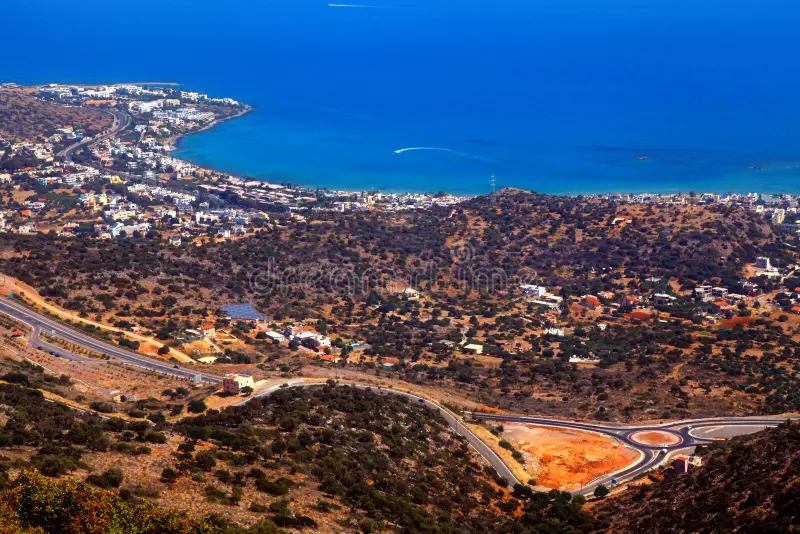
Greece is home to a treasure of historical sites for tourists that have influenced human civilization. Tourists who want to visit this ancient land should check out these top 10 must-see historical sites.
1. The Acropolis Greece:
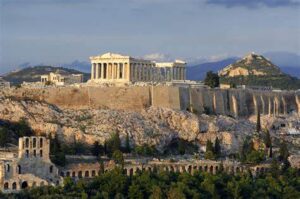
Tourists must visit the Acropolis of Athens for a glimpse of ancient Greek historical sites and architecture.
The Acropolis, perched on a rocky outcrop, is a UNESCO World Heritage site of great cultural significance.
Explore iconic structures like the Parthenon, Erechtheion, Temple of Athena Nike, and Propylaea at the Acropolis in Athens.
Ancient temples and monuments display the finesse of Greek architecture, providing insight into their religious beliefs and cultural practices.
Ancient temples and monuments display the finesse of Greek architecture, providing insight into their religious beliefs and cultural practices.
The Parthenon, dedicated to the goddess Athena, is perhaps the most famous structure on the Acropolis.
Its impressive Doric columns and intricate friezes are a testament to the skill and craftsmanship of the ancient Greek architects and sculptors.
The Erechtheion, with its famous Porch of the Caryatids, is another highlight of the Acropolis, known for its unique architectural features.
Visitors can admire the Temple of Athena Nike, dedicated to the goddess of victory, and the Propylaea gateway.
The nearby Acropolis Museum houses a vast collection of artifacts and sculptures, offering insights into ancient Greek art.
Aside from its historical and architectural significance, the Acropolis also offers stunning panoramic views of Athens and the surrounding landscape.
Tourists can enjoy historical sites and breathtaking views of the city, the Aegean Sea, and the nearby mountains from the high point of the Acropolis.
Overall, a visit to the Acropolis is a truly enriching experience for tourists interested in historical sites, history, archeology, and ancient civilizations.
It provides a window into Greece’s rich cultural heritage and allows visitors to appreciate the enduring legacy of one of the world’s most influential civilizations.
One of the most recognizable historic sites globally, the Acropolis stands tall above Athens.
It showcases remarkable achievements of Ancient Greek civilization, including iconic structures like the Parthenon, Erechtheion, Propylaia, and the temple of Athena Nike.
The recently opened Acropolis Museum nearby houses fascinating displays and artifacts from the Acropolis itself.
2. Ancient City of Akrotiri Greece:
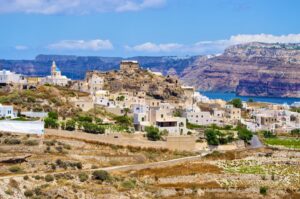
History and Archaeological Site:
The “Pompeii of the Aegean” is an ancient Minoan Bronze Age settlement located at the heart of Akrotiri.
Some of the historical sites of Akrotiri, which were buried under volcanic ash around 1600 BC, can be explored by tourists.
There are frescoes, pottery, and artifacts unearthed from the site that offer insights into the daily life, art, and culture of the ancient Minoans.
Places you can visit:
Red Beach:
One of Santorini’s historical sites and most famous beaches is known for its red volcanic sand and spectacular cliffs that attract tourists.
Tourists can enjoy the scenery while swimming, sunbathing, and taking in the sun.
Akrotiri Lighthouse:
The Akrotiri Lighthouse is located on a mountain overlooking the Aegean Sea and has magnificent views of the island.
Caldera Views:
The caldera cliffs have whitewashed buildings, blue-domed churches, and panoramic views of the volcanic caldera.
Wine Tasting:
The historical sites of Akrotiri are home to several famous wineries where tourists can sample typical Santorini wines, including Assyrtiko, Neytiri, and Vincento, from beautiful vineyards.
Boat Tours:
Explore the coastline and nearby volcanic islands with boat tours departing from Akrotiri, offering opportunities for swimming, snorkeling, and exploring hidden coves and sea caves.
Located in Santorini, Akrotiri is beautifully preserved and renowned for its incredible frescoes.
It is associated with the Minoans and has even been linked to the lost city of Atlantis.
The ruins of Akrotiri offer a glimpse into the sophisticated urban settlement that once thrived there, earning it the nickname “Minoan Pompeii”.
3. Mystras Greece:
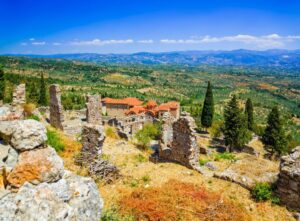
Mystras, Greece, is a captivating destination that offers a glimpse into the rich history and culture of the Byzantine Empire.
Located near the town of Sparti in the Peloponnese region, Mystras is famous for its medieval ruins, stunning scenery, and historical significance.
Here is a detailed guide about historical sites for tourists planning to visit Mystras:
History:
Mystras was founded in the 13th century by William II of Villehardouin, a Frankish ruler, and it soon became a thriving Byzantine city.
However, it reached its peak during the 14th and 15th centuries under the rule of the Byzantine Emperor, John VI Kantakouzenos.
The city flourished as a cultural, religious, and economic center until it was abandoned in the 19th century.
Attractions:
1. The Citadel:
Perched on a steep hill, the Citadel is the heart of Mystras.
Here, visitors can explore a labyrinth of well-preserved Byzantine churches, palaces, and fortifications.
Highlights include the Palace of the Despots, a majestic fortress with panoramic views of the surrounding valley, and the Church of Agios Demetrios, adorned with exquisite frescoes depicting scenes from the Bible and Byzantine history.
2. Churches and Monasteries:
Mystras is home to numerous churches and monasteries, each showcasing remarkable Byzantine architecture and artistry.
The Church of Hagia Sophia, dating back to the 14th century, features stunning mosaics and intricate marble carvings.
The Pantanassa Monastery, founded in the 15th century, is renowned for its serene atmosphere and beautiful iconography.
3. Archaeological Museum:
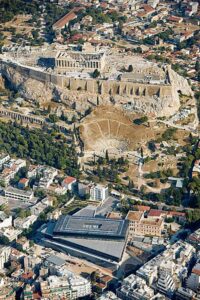
Located within the Citadel, the Archaeological Museum of Mystras houses a remarkable collection of artifacts unearthed from the site, including pottery, sculptures, and religious relics.
The museum provides valuable insights into the daily life, art, and architecture of Byzantine Mystras.
4. Lower Town Greece:
Descending from the Citadel, visitors can explore the Lower Town, where the remains of medieval houses, streets, and public buildings offer a glimpse into everyday life in Mystras.
Don’t miss the Church of Our Lady of Hodegetria, adorned with splendid frescoes, and the remains of the Palace of the Palaiologos, once the residence of the Byzantine imperial family.
5. Nature Trails:
Surrounded by lush greenery and scenic vistas, Mystras offers excellent hiking opportunities for nature enthusiasts.
Several well-marked trails wind through the surrounding hills, offering stunning views of the Byzantine ruins and the Laconian plain below.
Tips for Visitors:
Guided Tours:
Consider joining a guided tour to gain deeper insights into Mystras’ history and architecture.
Knowledgeable guides can enhance your experience by providing context and interpretation.
Comfortable Footwear:
Given the steep terrain and uneven paths, wearing sturdy walking shoes is essential for exploring Mystras comfortably.
Water and Sun Protection:
Remember to carry plenty of water and sunscreen, especially during the summer months, as Mystras can get hot and sunny.
Photography:
Photography enthusiasts will find endless opportunities to capture breathtaking vistas, ancient architecture, and intricate details throughout Mystras.
Just be mindful of any restrictions on photography within churches and museums.
Transportation:
By Car: Mystras is easily accessible by car from nearby towns such as Sparti and Tripoli. The site offers ample parking facilities for visitors.
Public Transport:
While public buses connect Sparti to other major cities in Greece, reaching Mystras by public transport may require additional transfers or a short taxi ride from Sparti.
Accommodation and Dining:
Hotels and Guesthouses:
There are several hotels, guesthouses, and traditional accommodations available in Sparti and the surrounding area, catering to various budgets and preferences.
Local Cuisine:
Don’t miss the opportunity to savor traditional Greek cuisine at local tavernas and restaurants in Sparti.
From hearty souvlaki and moussaka to fresh seafood and Greek salads, there’s something to delight every palate.
Conclusion:
Mystras offers a captivating journey through Byzantine history, art, and architecture, set amidst the stunning landscapes of the Peloponnese.
Whether you’re a history buff, a nature lover, or simply seeking an immersive cultural experience, a visit to Mystras promises unforgettable memories and a deeper appreciation for Greece’s rich heritage.
Situated on a hill overlooking Sparta, Mystras was built in the 13th century by William II of Villehardouin.
This archaeological site, now listed as a UNESCO World Heritage site, boasts churches, palaces, houses, and a famous fortress.
During its active period, these structures were considered architectural gems, known as the “wonders of Morea”.
4. Temple of Hephaestus Greece:
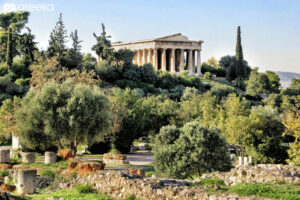
Located in Athens, this well-preserved Doric temple dedicated to the god Hephaestus is a testament to ancient Greek craftsmanship.
The Temple of Hephaestus, also known as the Hephaisteion or Hephaestion, is one of the best-preserved ancient Greek temples, is one of the historical sites and a must-see attraction for tourists visiting Athens, Greece.
Here is a detailed guide about historical sites for tourists interested in exploring this remarkable archaeological site:
It is a fascinating destination for tourists looking to explore the tradition of old Athens and immerse themselves in the world of classic antiquities.
This is due to its attractive architecture, rich history, and the cultural significance of its well-maintained historical sites.
5. Mycenae Greece:
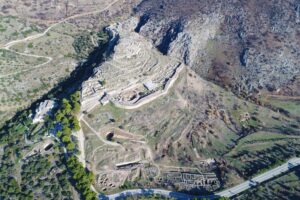
An ancient city with impressive cyclopean walls, Mycenae was a major center of Mycenaean civilization. Explore the Lion Gate, royal tombs, and the Treasury of Atreus.
Mycenae, located in the northeastern Peloponnese region of Greece, is an ancient archaeological site steeped in myth, history, and intrigue.
It was once a major center of Greek civilization and played a significant role in the development of ancient Greek culture.
For tourists interested in exploring this captivating destination, here’s a detailed guide:
History and Mythology:
Legendary Origins:
According to Greek mythology, Mycenae was founded by Perseus, the legendary hero known for slaying the Gorgon Medusa.
The city gained prominence under the reign of Perseus’ descendants, including King Agamemnon, who famously led the Greeks in the Trojan War.
Mycenaean Civilization:
Mycenae reached its peak during the Late Bronze Age (circa 1600–1100 BCE) and was a major center of the Mycenaean civilization.
It was a wealthy and powerful city-state, known for its impressive fortifications, sophisticated architecture, and extensive trade networks.
Archaeological Discoveries:
Excavations at Mycenae have unearthed a wealth of artifacts, including monumental tombs, palaces, and defensive structures, shedding light on the culture, art, and society of the Mycenaean era.
The most famous discovery is the “Mask of Agamemnon,” a gold funerary mask found in one of the royal tombs.
Attractions:
1. Cyclopean Walls:
The imposing Cyclopean walls encircling the acropolis of Mycenae are among the most impressive archaeological features of the site.
These massive stone walls, constructed without mortar using enormous blocks of stone, showcase the engineering prowess of the Mycenaeans and provide evidence of the city’s formidable defenses.
2. Lions’ Gate:
The Lions’ Gate is the main entrance to the citadel of Mycenae and is adorned with a relief depicting two lionesses flanking a central pillar.
This iconic symbol of Mycenae is considered one of the finest examples of Mycenaean sculpture and architecture.
3. Grave Circles:
Mycenae is home to several grave circles, including the Grave Circle A, where the famous “Mask of Agamemnon” was discovered.
These circular burial sites contain a series of royal tombs and offer insights into Mycenaean burial practices and rituals.
4. Treasury of Atreus (Tholos Tomb):
The Treasury of Atreus, also known as the Tomb of Agamemnon or Tholos Tomb, is a remarkable beehive-shaped burial chamber located outside the citadel.
Built with massive stone blocks and featuring a monumental entrance known as a dromos, this impressive structure is one of the best-preserved tholos tombs in Greece.
5. Archaeological Museum:
The Archaeological Museum of Mycenae houses a diverse collection of artifacts unearthed from the site, including pottery, weapons, jewelry, and sculptures.
Highlights include the “Mask of Agamemnon,” intricate frescoes, and objects of everyday life from the Mycenaean period.
Visiting Tips:
Guided Tours:
Consider joining a guided tour of Mycenae to gain deeper insights into the history, mythology, and significance of the archaeological site.
Knowledgeable guides can provide context and interpretation, enhancing your understanding and appreciation of the ancient ruins.
Comfortable Footwear:
The terrain at Mycenae can be uneven and rocky, so wearing sturdy walking shoes is essential for exploring the site comfortably.
Sun Protection:
Mycenae can get hot and sunny, especially during the summer months, so remember to wear sunscreen, a hat, and sunglasses to protect yourself from the sun.
Accessibility:
While most areas of Mycenae are accessible to visitors, some parts of the site may have steep paths or stairs. Visitors with mobility issues should plan accordingly and inquire about accessibility options.
How to reach your destination with ease and convenience:
By Car:
Mycenae is easily accessible by car from major cities in the Peloponnese, including Athens, Corinth, and Nafplio. The site offers parking facilities for visitors arriving by car.
Public Transport:
Public buses and organized tours are available from nearby towns, such as Nafplio and Argos, to Mycenae. Visitors can also hire taxis or arrange transportation through local tour operators.
Accommodation and Dining:
Hotels and Guesthouses: Accommodation options are available in nearby towns such as Nafplio, Argos, and Corinth, offering a range of hotels, guesthouses, and traditional accommodations to suit various budgets and preferences.
Local Cuisine: After exploring Mycenae, visitors can indulge in traditional Greek cuisine at tavernas and restaurants in nearby towns, sampling local specialties such as moussaka, souvlaki, fresh seafood, and Greek salads.
Conclusion:
Mycenae stands as a timeless testament to the achievements of ancient Greek civilization and continues to fascinate visitors with its rich history, mythology, and archaeological treasures.
A visit to this iconic site offers a journey back in time to the height of the Mycenaean era, where legendary heroes, intricate architecture, and monumental tombs await exploration.
Whether you’re a history enthusiast, a mythology buff, or simply seeking to immerse yourself in the wonders of antiquity, Mycenae promises an unforgettable experience filled with awe-inspiring discoveries and cultural insights.
6. Grandmasters Palace (Rhodes) Greece:
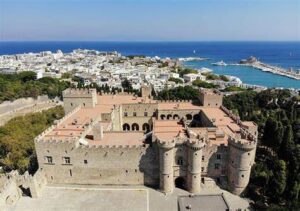
Situated in Rhodes Old Town, this medieval palace served as the residence of the Knights of St. John during the Crusades.
7. Meteora Greece:
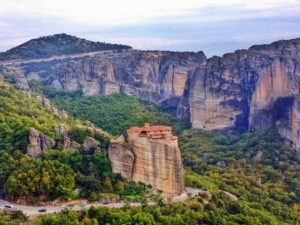
These monasteries perched atop towering rock formations offer breathtaking views and a glimpse into the spiritual life of monks.
Meteora, Greece, is a unique and awe-inspiring destination renowned for its towering rock formations, monasteries perched atop sheer cliffs, and stunning natural landscapes.
Located in the central region of Greece, near the town of Kalambaka, Meteora attracts tourists from around the world seeking to marvel at its breathtaking scenery, explore its religious and cultural heritage, and embark on outdoor adventures.
Here’s a detailed guide for tourists planning to visit the historical sites of Meteora:
Geological Formation:
Limestone Pillars:
Meteora’s geological landscape is characterized by massive rock formations, consisting of sandstone and conglomerate rock, that rise dramatically from the surrounding plains.
These imposing pillars, reaching heights of up to 400 meters, were formed over millions of years through the processes of erosion and weathering.
Sacred Site: The word “Meteora” translates to “suspended in the air,” aptly describing the gravity-defying monasteries that cling to the sheer cliffs of the rock formations.
The area’s geological uniqueness, coupled with its spiritual significance, has made Meteora a UNESCO World Heritage Site.
Religious and Cultural Heritage:
Monastic Community:
Meteora is home to a historic monastic community dating back to the 14th century, when monks seeking solitude and refuge from religious persecution began to inhabit the inaccessible rock formations.
Over time, a total of 24 monasteries were built, although only six are still active today.
Historic Monasteries:
The six remaining monasteries—Great Meteoron, Varlaam, Rousanou, St. Nicholas Anapausas, St. Stephen, and Holy Trinity—are architectural marvels, each with its own unique history, frescoes, and religious artifacts.
Visitors can explore the monasteries’ chapels, libraries, and courtyards, and admire panoramic views of the surrounding landscape from their elevated vantage points.
Spiritual Retreat:
For centuries, Meteora has served as a place of spiritual contemplation, prayer, and pilgrimage for Orthodox Christians and travelers alike.
The monasteries’ remote location and serene atmosphere offer visitors an opportunity for reflection and introspection amid the natural beauty of the surroundings.
Tourist Activities:
1. Monastery Tours:
Embark on guided tours of the monasteries to learn about their history, architecture, and religious significance.
Most tours include visits to several monasteries, transportation between sites, and commentary from knowledgeable guides.
2. Hiking and Rock Climbing:
Explore Meteora’s rugged terrain and scenic trails on foot through guided hiking excursions or self-guided treks.
Alternatively, adventurous travelers can try their hand at rock climbing, with numerous climbing routes available for varying skill levels.
3. Sunset and Sunrise Views:
Experience the magical beauty of Meteora at sunrise or sunset, when the golden light bathes the rock formations in a warm glow, creating breathtaking photo opportunities.
Several vantage points offer panoramic views of the landscape, including the sunset rock and sunrise rock.
4. Photography:
Capture the dramatic landscapes, ancient monasteries, and vibrant flora and fauna of Meteora through photography.
Whether you’re a professional photographer or an amateur enthusiast, Meteora offers endless opportunities for stunning shots.
Practical Tips:
Operating Hours:
The monasteries ‘hours of operation vary, and some days may be off for religious holidays.
It’s advisable to check the opening times in advance and plan your visit accordingly.
Dress Code:
When visiting the monasteries, visitors are required to dress modestly, covering their shoulders and knees.
Women may be asked to wear skirts or scarves provided by the monasteries if their attire does not meet the dress code.
Transportation:
Meteora is accessible by train, bus, or car from major cities in Greece, such as Athens and Thessaloniki. Once in the area, visitors can explore Meteora by car, bicycle, or organized tours.
Accommodation:
There are several hotels, guesthouses, and traditional accommodations available in the nearby town of Kalambaka and the village of Kastraki, offering a range of options to suit different budgets and preferences.
Conclusion:
Meteora offers a mesmerizing blend of natural beauty, cultural heritage, and spiritual significance that captivates the hearts and imaginations of visitors.
Whether you’re drawn to its towering rock formations, historic monasteries, or outdoor adventures, a visit to Meteora promises an unforgettable experience filled with wonder, inspiration, and discovery.
Immerse yourself in the timeless allure of this extraordinary destination and create memories that will last a lifetime.
8. Delphi Greece:
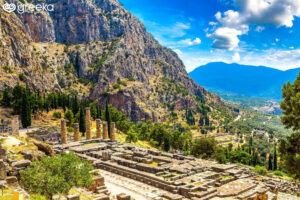
The Oracle of Delphi was a revered sanctuary where ancient Greeks sought guidance from the priestess Pythia.
The temple of Apollo and the ancient theater are prominent.
9. Ancient Agora (Athens) Greece:
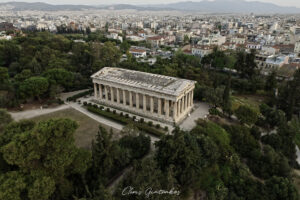
Once the heart of Athens, the Ancient Agora was a bustling marketplace and civic center. Visit the Stoa of Attalos and the Temple of Hephaestus.
Socrates, Plato, and Aristotle, among other renowned philosophers who regularly spoke at The Agora with students and fellow citizens, were a part of the conversation.
10. Epidaurus Greece:
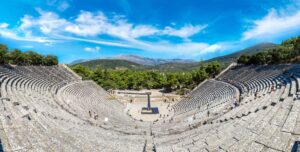
Known for its well-preserved ancient theater, Epidaurus was a healing sanctuary dedicated to the god Asclepius.
These sites not only offer historical insights but also transport visitors back in time to the glory days of ancient Greece.
Epidaurus, located in the northeastern part of the Peloponnese peninsula in Greece, is an ancient sanctuary and archaeological site renowned for its well-preserved theater and healing center.
Famed for its architectural brilliance and therapeutic traditions, Epidaurus continues to attract tourists seeking to explore its historical sites and significance, cultural heritage, and natural beauty.
<p>Here’s a detailed guide for tourists interested in visiting the historical sites of Epidaurus:
History and Significance:
Healing Sanctuary:
Asclepius, the ancient Greek goddess of healing and medicine, was given the name Epidaurus.
The sanctuary was famous for its healing practices from the 6th to 4th centuries BCE, including dream cures, herbal remedies, and ritual purification.
Theater of Epidaurus:
The most iconic feature of Epidaurus is its ancient theater, renowned for its exceptional acoustics and architectural perfection.
Built in the 4th century BCE, the theater hosted dramatic performances, musical concerts, and religious festivals, attracting audiences from across the ancient Greek world.
Cultural Center: In addition to its healing sanctuary and theater, Epidaurus was a cultural and religious center, featuring temples, sanctuaries, and athletic facilities.
It also served as a venue for the Panhellenic Games, including the Epidaurian Games, which celebrated the athletic prowess and competitive spirit of ancient Greek athletes.
Attractions:
1. Ancient Theater of Epidaurus:
The Ancient Theater of Epidaurus is a masterpiece of classical Greek architecture, renowned for its exceptional acoustics and aesthetic beauty.
Carved into the natural landscape of the Peloponnesian hills, the theater features a semicircular orchestra, tiered seating, and a stunning backdrop of lush greenery and distant mountains.
2. Sanctuary of Asclepius:
The Sanctuary of Asclepius encompasses a series of religious and healing structures, including temples, altars, and baths, dedicated to the worship of Asclepius and the practice of ancient Greek medicine.
Visitors can explore the remains of the sanctuary and learn about the rituals and therapies performed there.
3. Tholos of Epidaurus:
The Tholos of Epidaurus, a circular building near the sanctuary, is thought to have been a ceremonial center.
Although only a few columns remain standing today, the Tholos is an intriguing architectural feature of Epidaurus.
4. Archaeological Museum of Epidaurus:
The Archaeological Museum of Epidaurus houses a collection of artifacts unearthed from the site, including sculptures, pottery, inscriptions, and architectural fragments.
Highlights include statues of Asclepius and his family, as well as medical instruments and votive offerings dedicated to the god of healing.
Tourist Tips:
Operating Hours:
The archaeological site of Epidaurus is open to visitors daily, with varying operating hours depending on the season.
It’s advisable to check the official website or local tourism information for the most up-to-date information on opening times and ticket prices.
Guided Tours:
Guided tours of Epidaurus are available, offering visitors insights into its history, architecture, and significance.
Knowledgeable guides can provide context and interpretation, enhancing your understanding and appreciation of the site.
Comfortable Footwear:
Sturdy walking shoes are essential for exploring the uneven and rocky terrain at Epidaurus comfortably and safely.
If you want to go to the theater and sanctuary, be prepared for some uphill walking.
Sun Protection:
Epidaurus can get hot and sunny, especially during the summer months, so remember to wear sunscreen, a hat, and sunglasses to protect yourself from the sun.
Nearby Attractions:
Nafplio:
Explore the charming seaside town of Nafplio, located nearby, known for its picturesque architecture, historic fortresses, and vibrant waterfront promenade.
Mycenae:
Discover Mycenae’s ancient site with its citadel, tombs, and archaeological treasures dating back to the Bronze Age.
Corinth Canal:
Take a scenic drive to the Corinth Canal, linking the Gulf of Corinth with the Saronic Gulf.
Conclusion:
Epidaurus offers tourists a journey through ancient Greek historical sites, culture, and spirituality with its renowned theatre, healing sanctuary.
A trip to Epidaurus will make for an unforgettable experience filled with wonder, inspiration, and discovery, whether you are drawn to its architectural genius, therapeutic traditions, or natural beauty.
Explore the ancient sanctuary’s allure and uncover its storied past amidst the stunning Peloponnese landscapes to immerse yourself in history.







